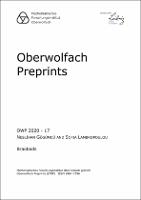| dc.contributor.author | Gügümcü, Neslihan | |
| dc.contributor.author | Lambropoulou, Sofia | |
| dc.date.accessioned | 2020-09-03T07:10:32Z | |
| dc.date.available | 2020-09-03T07:10:32Z | |
| dc.date.issued | 2020-09-03 | |
| dc.identifier.uri | http://publications.mfo.de/handle/mfo/3771 | |
| dc.description.abstract | Braidoids generalize the classical braids and form a counterpart theory to the theory of planar knotoids, just as the theory of braids does for the theory of knots. In this paper, we introduce the notion of braidoids in $\mathbb{R}^2$, a closure operation for braidoids, we prove an analogue of the Alexander theorem, namely an algorithm that turns a knotoid into a braidoid, and we formulate and prove a geometric analogue of the Markov theorem for braidoids using the $L$-moves. | en_US |
| dc.language.iso | en_US | en_US |
| dc.publisher | Mathematisches Forschungsinstitut Oberwolfach | en_US |
| dc.relation.ispartofseries | Oberwolfach Preprints;2020,17 | |
| dc.subject | Braidoids | en_US |
| dc.subject | Knotoids | en_US |
| dc.subject | Markov theorem | en_US |
| dc.subject | Alexander theorem | en_US |
| dc.title | Braidoids | en_US |
| dc.type | Preprint | en_US |
| dc.rights.license | Dieses Dokument darf im Rahmen von § 53 UrhG zum eigenen Gebrauch kostenfrei heruntergeladen, gelesen, gespeichert und ausgedruckt, aber nicht im Internet bereitgestellt oder an Außenstehende weitergegeben werden. | de |
| dc.rights.license | This document may be downloaded, read, stored and printed for your own use within the limits of § 53 UrhG but it may not be distributed via the internet or passed on to external parties. | en |
| dc.identifier.doi | 10.14760/OWP-2020-17 | |
| local.scientificprogram | OWLF 2019 | en_US |
| local.series.id | OWP-2020-17 | en_US |
| local.subject.msc | 57 | en_US |
| dc.identifier.urn | urn:nbn:de:101:1-2020090913574527370981 | |
| dc.identifier.ppn | 1729828191 | |

